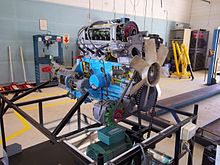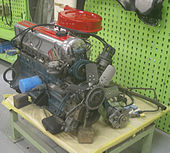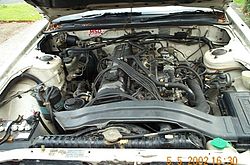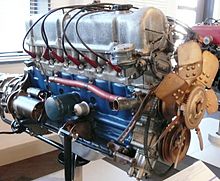- Nissan L engine
-
The Nissan L series of automobile engines ranged from 1.3 L to 2.8 L in both straight-4 and straight-6 configurations and were produced from 1967 through 1986. This was the engine of the Datsun 240Z sports car as well as the Datsun 510 and the first Nissan Maxima. These engines are known for their reliability, durability, and parts interchangeability. It is a 2-valve per cylinder SOHC non-crossflow engine, with an iron block and an aluminium head. The four cylinder L series engines were replaced with the Z series and later the CA series, while the six cylinder L series engines were replaced with the VG series and RB series.
The design is often incorrectly attributed to Mercedes-Benz. In 1966 Prince Motor Company merged with Nissan. At the time of the merger, Prince was licensed to produce copies of the four and six-cylinder engines. Prince Motor Company later refined the design such that it no longer needed licensing. The engine still resembles a Mercedes in many ways, particularly the valve train.
Contents
Straight-4
L13
The L13 appeared in 1967, but was not available in the United States. It produces 77 hp (57 kW). The L13 was essentially a de-stroked L16.
Applications:
- Nissan Bluebird (510)
L14
The L14 was destined for non-U.S.A. markets like South America, Europe, and Africa.
Applications:
- Nissan Bluebird (510)
- A10 Stanza/Violet (UK)
- Nissan Sunny Excellent (PB210)
- GR-1 concept (1975)
L16
The L16 was a 1,595 cc engine produced from 1967 through 1973 for the Datsun 510. It produces 96 hp (72 kW) through 1971 then 92 hp (69 kW). The L16 replaced the Prince G-16.
Applications:
- Nissan Bluebird (510)
- Nissan 160B sedan
- Datsun 521 pick-up (1970–1972)
- Datsun 620 pick-up (1972–1974)
- Datsun Stanza (A10) (Australian and United Kingdom markets) (1973–1981)
When this engine was installed in a 1972 Canadian 510 sedan model with gearbox (manual transmission), 2 sets of points were installed in the distributor and this second set of points was in circuit only in 3rd gear to obtain a different dwell angle. A similar arrangement exists in the US-spec 510/610 cars and 521/620 pickup trucks for the years 1970-73
L16S
The L16S was an engine that was used in the 910 bluebird Sedan. This engine was equipped with an electronically controlled carburetor.
Applications:
- Nissan Bluebird (910)
L16T
The L16T was basically the same as the L16 but had twin SU carbs, flat top pistons (same as ones used in 240Z) and a slightly different head. It produces 109 hp (81 kW).
Applications:
- Nissan Bluebird (510) - At least in European version, where it was known as Datsun 1600SSS (P(L)510), 68-72.
Note the L in PL was for left hand drive models.
L16P
The L16P is the LPG version of the L16.
Applications:
- Nissan Bluebird (510)
- Nissan Violet (710)
L18
The L18 was a 1770cc engine produced from 1972 through 1976. It produces 105 hp (78 kW)@5000 RPM. The L18 replaced the Prince G-18 in 1975.
Applications:
- Nissan Bluebird/Datsun 1600 SSS (510)
- Datsun 610(1973)
- Datsun 180B
- Datsun 620 truck (1975)
- Datsun 710(1974)
- Datsun 720
- Datsun 810
- Nissan Silvia SOHC with Injection Bosch from 1979 to 1981
L18S
The L18S was an engine that was used in the 910 bluebird Sedan
Applications:
- 910 Nissan Bluebird
L18T
The L18T was basically the same as the L18 but had twin SU carbs, a high lift cam, 2 mm bigger inlet valves and 1 mm bigger exhaust valves. It was fitted to 610 Bluebird 180B SSS, 910-U Bluebird 1.8GL "Hardtop" coupé for the UK market. It produces 110 hp (82 kW). Also Bluebird SSS Hardtop Coupe for General LH Market. ( Chassis 910 )
L18P
The L18P is the LPG version of the L18 engine.
Applications:
- Datsun Bluebird 810
- Datsun Bluebird 710
L20B
The L20B was a 1,952 cc (85.0 x 86.0 mm) engine produced from 1975 through 1985. It produces 97 hp (72 kW) in 1977-78 form with 102 lb·ft (138 N·m) of torque as installed in the 200SX. [1] The L20B engine utilized larger diameter (60mm) main bearings than its earlier L-series 4-cylinder predecessors. The engine used a carburetor but switched to fuel injection (and round instead of square exhaust ports) in some non-USA markets in 1977. Carburetors were used in all trucks until the L20B was replaced with the Nissan Z engine series. There were six versions of the L20B in the US- U60,U67,U95 used in cars, and U60,U67,B98,04W, and 05W used in trucks. In the US, carburetors were used on all gasoline pick-ups until fuel injection became available as an option in the 1985 720ST, and injection became standard equipment with the introduction of the 1987.5 D21 Hardbody pickups. To avoid confusion with the six-cylinder L20, Nissan called this engine the L20B and redesignated their six-cylinder engine L20A.
Applications:
- Datsun 610
- Datsun 710
- Datsun 200B
- Datsun 620 (1976–1979, 110 hp)
- Datsun 200SX
- Datsun 510
- Datsun 720 (1980)
L22
This engine was used in all US-spec. gasoline-powered pick-ups in 1981, 1982 and early 1983, utilizing a Z22 crankshaft and larger-bore block and cross-flow head, giving approximately 2.2L of displacement. This version of the engine produces more low-rpm power than the smaller 4 cylinder L Series, but suffers from compromised high-rpm power due to the smaller valves/lower valve lifts required in the cross-flow NAPS-Z (Nissan Air Pollution System) cylinder head.
LZ (competition)
The "LZ" twin cam head was designed to give a power boost to the Datsun L series engine for competition purposes. The best way to increase output was to improve its breathing. The solution chosen was 4 valves per cylinder operated by two camshafts in a cam box. Combustion chamber valve angles were kept quite shallow to minimise gas flow interference from "twin in-cylinder vortices". The shallow angle 4-valve system, gives greatly improved cylinder fill through high valve lifts that can be used with large valve overlap periods. This system was later used by Suzuki on their GSX 1100R engines to great effect.
There are two different LZ cylinder heads. The early head is the same thickness as a normal L series head. The engine using the first head was referred to as the L14 twin cam. There was no mention of Z in the title. This L14 twin cam head engine has flat exit side exhaust ports, the early 12 bolt rocker cover and the coolant discharge on the inlet side of the head. All early twin cam engines appear to have the 14 bolt rocker cover (6 for the cover and 8 for the bolt-in plug holders). Later engines use the full flat cover with six bolts to secure it.
The LZ engine was built purely for Datsun/Nissan competition use. Engine size can vary between 1400cc (LZ14) in the PB110 "1200", 1600 cc in the PB210, 1800 CC in the 710 2.0 litres in the PA10 Stanza, to 2.2 liter in the 910 bluebird rally cars. The naturally aspirated LZ engines used 45 mm or 50 mm Solex carburettors depending on capacity. The LZ engine found its way into many categories, from "Datsun Works" rally cars, Formula Pacific, Group 4 (racing), Group 5 (racing) and Group C.
In some Japanese racing classes the LZ engine is fitted with low compression pistons and a "T05B" turbocharger. These engines are electronically fuel injected. A very successful example of the LZ turbo was in the famous Japanese "White Lightning" Silvia and "Tomica" R30 Skyline, both driven by Hoshino in the mid 1980's. The LZ turbo engine was also used in the 1986 Nissan March 85G Le Mans car.
The LZ turbo engine was tuned to produce 570 PS at 7,600 rpm and 539 Nm at 6,400 rpm. The original LZ20B turbo engine used in the 1983 Nissan Silvia (S12) "White Lightning" Group 5 race car, produced 500 PS at 8,000 rpm.
The LZ14 engine for the Formula Pacific race cars produces 205 PS at 10,200 rpm. For qualifying and non endurance events the LZ14 can be tweaked to produce 240 PS at 11,000 rpm. The LZ14 is naturally aspirated and has a 66 mm stroke and 87.8 mm bore (1,598 cc).
The LZ engine uses a standard L series engine block to mount the DOHC cylinder head. Usually the bottom end is dry sumped using a Tsubakimoto dry sump pump. The crankshaft used is a Nismo chrome moly "8 bolt flywheel" type. Connecting rods are various length, Cosworth style, to suit the engine stroke. The rod caps have aircraft grade rod bolts and are dowelled. Pistons are thin ring forged units.
The head was available for purchase from Nissan (Nismo) and was sanctioned by the FIA. The LZ14 (1,598 cc) was used during the 1973 Japanese GP, taking the top three positions. In open wheeler "Formula Pacific" racing the LZ14 engine dominated competition in most events it was entered in. It received multiple top rankings in some events.
LD20/LD20T
There is also a diesel version of the 4-cylinder L-series, used in amongst others the Bluebird 910 and the Vanette. (but strangely enough was not in the 720 pickup, which had the SD22/25 when diesel powered, while the gas version most often has the L-series engine. However, in case of a conversion of a gas powered 720 to diesel, it will be much easier to use a LD20 because it fits on the original gearbox and engine mounts.) The N/A version produced 65 hp @4600rpm and 12,5 kgm @2400rpm, later 67 hp/13 kgm. The turbo version has 79 hp@4400rpm and 17 kgm @2400 rpm. The LD engine must not be confused with the Nissan SD engine which is a totally different engine.
- LD20-I
- 1,952 cc diesel engine pre-combustion chamber
65 PS (47.8 kW; 64.1 bhp) at 4,600 rpm
12.5 kg·m (123 N·m; 90 lb·ft) at 2,400 rpmModels:
- Vanette (C120)
- Largo (GC120)
- LD20-II
67 PS (49.3 kW; 66.1 bhp) at 4,600 rpm
13.0 kg·m (127 N·m; 94 lb·ft) at 2,400 rpmModels:
- Bluebird (910 & U11)
- Vanette (C22)
- Largo (GC22)
- LD20T
79 PS (58.1 kW; 77.9 bhp) at 4,400 rpm
17.0 kg·m (167 N·m; 123 lb·ft) at 2,400 rpmModels:
- Largo (GC120 & GC22)
- Homy / Caravan (E23 & E24)
Straight-6
L20/L20A
The L20 is a SOHC 12-valve engine produced from 1967. A 78.0 mm bore and 67.9 mm stroke meant a displacement of 1,998 cc. Later, this engine became the L20A to avoid confusion with the four-cylinder L20B introduced in 1975. The L20 was used in the Nissan Skyline 2000 GT and Nissan Cedric 130, producing 109 hp (81 kW) for the 2000 GT and 123 hp (92 kW) for the Cedric.
The L20A was used in HLC210 (Nissan Laurel/Datsun 200L, 75-77), G610 Bluebird U 2000 GT and GTX, 230/330 Series Cedrics, and HIJC31 (Laurel, 81-85). It produces 115 hp (86 kW).
L20ET
The L20ET is a turbo engine developed by the Nissan Motor Company. It is a 12 valve, 6 cylinder, fuel injection engine with a single chain driven cam, turbo (non intercooled), and a non crossflow head. It produces 144 hp (107 kW).
It was released in the early 1980s and fitted to the Skyline, Laurel, Leopard, Gloria, and Fairlady Z lines of automobiles.
This engine was the first engine out of Japan to ever receive a turbo.
L20P
The L20P is the LPG version of the L20 engine.
Applications:
- Nissan Cedric (330, 430 and Y30)
- Nissan Gloria (330, 430 and Y30)
L23
The L23 was a 2,262 cc (2.3 L; 138.0 cu in) engine produced in 1968. It produces 123 hp (92 kW). This engine was produced in limited numbers and is therefore rare. The L23 was replaced by the L24 the following year. Bore and stroke were 83mm and 67.9mm, respectively.
Applications:
- 1968 Nissan Cedric
L24
The L24 was a 2,393 cc (2.4 L; 146.0 cu in) engine produced from 1970 through 1984. It produces 130 PS (96 kW) and the version with twin side draught SU carbs produces 150 PS (110 kW). Bore is 83.0 mm and stroke is 73.7 mm.
A single carburettor version of the same engine was also standard in the Laurel sedan (240L) for the Middle eastern markets, in the years 1982-1984. While the last generation Cedric to use this engine in Japan was the 230-series (1971–1975), Yue Loong of Taiwan installed it in 430-series Cedrics at least as late as 1984.[2]
Applications:
- Nissan Fairlady Z (Datsun 240Z)--150 hp
- Nissan Cedric--130 hp
- Nissan Skyline C110
- Nissan Laurel
L24E
Electronic fuel injection was added for the L24E, produced from 1977 through 1986. It produced 138 hp (103 kW) and 132 lb-ft torque (180 Nm).[citation needed] This engine was used in the Nissan Laurel C32.
Applications:
- Datsun 810
- Nissan Maxima (1981–1984)
- Nissan Laurel
- Nissan Skyline R30
L26
The L26 is the larger 2,565 cc (2.6 L; 156.5 cu in). Bore is 83.0 mm and stroke is 79 mm. It was produced from 1973 through 1978. It produces 140–162 PS (103–119 kW). In 1975, the L26 replaced the Prince G-20.
Applications:
L28
The L28 is a 2,753 cc (2.8 L; 168.0 cu in) 12 valve engine. Bore is 86.0 mm and stroke is 79 mm.
Applications:
- Nissan Cedric 330
- Nissan Gloria 330
- Nissan Laurel C130 and C230
- Nissan Civilian W40 and W41
- Nissan Patrol 160 and 260
L28E
The L28E is the enlarged 2,753 cc (2.8 L; 168.0 cu in) engine produced from 1975 to 1984 with dish-top pistons and a resulting compression ratio of 8.3:1. For model year 1981 through model year 1983, the L28E received flat-top pistons and a high quench head, raising the compression ratio to 8.8:1, and thus increasing the power rating from 135 PS (99 kW) (1975–1980) to 145 PS (107 kW) (1981–1983).
Applications:
- Dome Zero
- Nissan/Datsun 280Z (170 PS (125 kW))
- Nissan 280ZX (170 PS (125 kW))
- Nissan Patrol 160
- Nissan Leopard
- Nissan AD-2
L28ET
The L28E was turbocharged in December 1980 to produce the L28ET for the 280ZX Turbo. The L28ET was produced through June 1983. The early versions had adjustable mechanical rockers though these were phased out after September 1982 in favor of hydraulic rockers. The L28ET produces 180 bhp (134 kW) at 5600 RPM and 203 lb·ft (275 N·m) at 2800 RPM.[3]
The L28ET used a single Garrett AiResearch TB03 internally wastegated turbocharger and no intercooler. Boost was limited to 6.8 psi. Other modest changes were made to the turbo model, with static compression reduced to 7.4:1, and automatic transmission models were given a higher-volume oil pump. The most significant change aside from the turbocharger itself was the introduction of a new engine control systems, Nissan's Electronic Concentrated Control System (ECCS).
Applications:
- Nissan 280ZX Turbo
LD28
The LD28 is the diesel-version of the L28 engine. Robust 7-main bearing block design, like all L-series six-cylinder engines.
- LD28
- 2,792 cc
- pre-combustion chamber
91 PS (66.9 kW; 89.8 bhp) at 4,600 RPM
17.3 kg·m (170 N·m; 125 lb·ft) at 2,400 RPMApplications:
- Nissan Gloria 430 and Y30
- Nissan Cedric 430 and Y30
- Nissan Laurel C31 and C32
- Nissan Skyline C210 and R30
- Datsun 810 G910
- Datsun Maxima G910
- rare International Scout option[citation needed]
LD28T (turbocharged)
There was no factory turbocharged LD28 engine, but there is a closely related RD28T engine. Applications:
- Nissan Patrol (Y60 & Y61 Safari export version)
L2.9 ~ 3.2
When fitting an L28 with an LD28 crankshaft with standard bored cylinders it increases the engine displacement from 2.8 L (2753 cc) to about 2900 cc. It was never actually produced by Nissan but it is a very easy and common modification to the L28 done by many Skyline and Z car enthusiasts. The most popular modification is the 3 mm overbored(89 mm) L3.1 liter(3096cc) some add a turbo or two, but the more common setup is the triple Solex or Weber carburators. The only downside is that LD28 cranks are expensive- used units are scarce, but new units are available from the factory. Fully counterweighted 83 mm stroke and even 85 mm stroke cranks can be bought from aftermarket companies such as Crower.
Without increasing bore size, fitting an L28 with the longer stroke LD28 crank will only result in 2.9L. In Japan and other parts of the world the popular "poormans mod" was the 3 mm~ overbore using the 89 mm ~ 90 mm Honda FT-500 / XL-500 motorcycle pistons along with the L14 rods. The real poorman would use the much cheaper/heavier 89 mm FJ20 or even KA24 engine pistons. All of these were cast pistons and had low endurance and would often fail when subjected to high compression and advanced ignition timing compared to custom forged pistons.
See also
References
- ^ James M. Flammang (1994). Standard Catalog of Imported Cars, 1946-1990. Iola, WI: Krause Publications, Inc.. pp. 169–170. ISBN 0-87341-158-7.
- ^ 1984 Yue Loong Cedric 807 (Catalog), Yue Loong Motor Company, 1984, http://tw.myblog.yahoo.com/ytseng3ford/article?mid=56731
- ^ by the Auto Editors of Consumer Guide (2007-11-19). "Nissan Z History". Auto.howstuffworks.com. http://auto.howstuffworks.com/nissan-z-history4.htm. Retrieved 2010-12-05.
External links
Nissan Motor Company Vehicles Current370Z • Advan • Altima • Aprio • Armada • Atlas • Bluebird • Bluebird Sylphy • Cabstar • Caravan • Civilian • Clipper • Cube • Dualis • Elgrand • Frontier • Freeson • Fuga • GT-R • Juke • Lafesta • Leaf • Livina Geniss • Maxima • March • Murano • Moco • Navara • Note • NV200 • NV400 • Otti • Paladin • Pathfinder • Patrol • Qashqai • Quest • Rogue • Safari • Sentra • Serena • Skyline • Teana • Tiida • Titan • Urvan • Versa • Wingroad • X-Trail • XterraPastDC-3 • 100NX • 1200 • 310 • 180SX • 200SX • B-210 • 240SX • 240Z • 280ZX • 300C • 300ZX • 350Z • 510 • 810 • Almera • Almera Tino • Altra (EV) • Avenir • Auster • Bassara • Be-1 • Caball • Cablight • Cedric • Cefiro • Cherry • Cima • Crew • Datsun Truck • Echo • Expert • Fairlady • Figaro • Gazelle • Gloria • Hardbody Truck • Hypermini • Homy • Interstar • Junior • Largo • Laurel • Leopard • Liberty • Mistral • Multi • NX • Pao • Pintara • Pino • Platina • Prairie • Presage • Presea • Primera • President • Pulsar • Pulsar GTI-R • R390 GT1 • R'nessa • Rasheen • Roadster-Road Star • S-Cargo • Saurus • Saurus Jr • Silvia • Sileighty • Skyline GT-R • Stanza • Stagea • Sunny • Terrano • Terrano II • Vanette • VioletConcept126X • 216X • 270X • 300 Bambu • 315-a • AA-X • Actic • AD-1 • AD-2 • AL-X • Alpha T • Amenio • AQ-X • AP-X • ARC-X • AXY • AZEAL • Bevel • Boga • C-Note • Chapeau • Chappo • Cocoon • CQ-X • Crossbow • CUE-X • Cypact • Duad • Dunehawk • Effis • ESV • Evalia • EV Guide II • EV Truck • FEV • FEV-II • Foria • Forum • Fusion • Gobi • GR-1 • GR-2 • GT-R • ideo • Intima • Jikoo • Judo • Jura • Kino • KYXX • Land Glider • LEAF • LUC-2 • MID4 • Mixim • mm.e • Moco • Nails • NCS • NEO-X • NRV-II • NX-21 • NV2500 • Pivo • Pivo 2 • Qazana • Redigo • Round Box • Serenity • Sport Concept • Stylish VI • Terranaut • Tone • Townpod • Trailrunner • TRI-X • URGE • UV-X • XIX • XVL • Yanya • ZarootEngines GRX-3 • UD12 • VRT35Marques Nissan • InfinitiSubsidiaries
and divisionsSee also ATTESA • Datsun • HICAS • Prince • Renault-Nissan Alliance • Nissan Shatai • UD Nissan Diesel • VVL • VVEL • dCi
Categories:- Nissan engines
Wikimedia Foundation. 2010.




